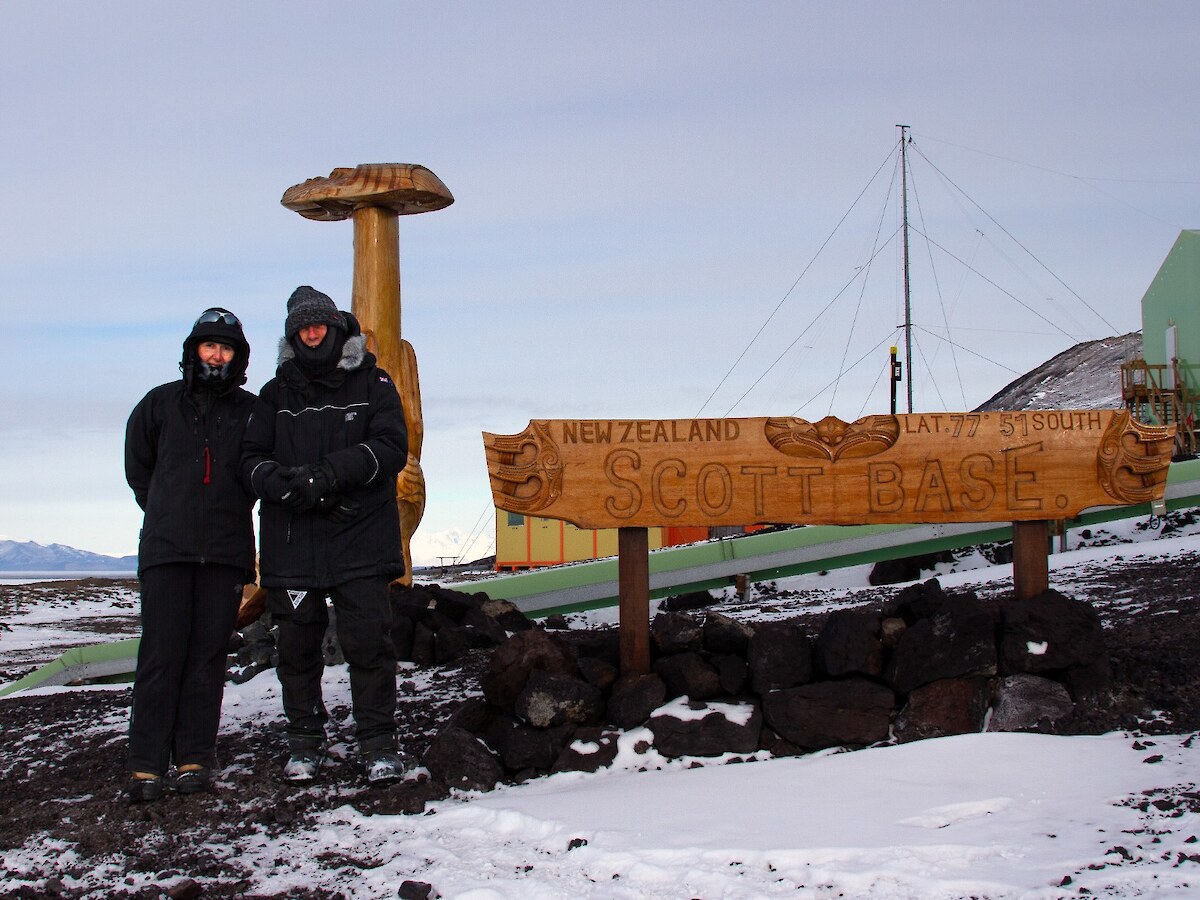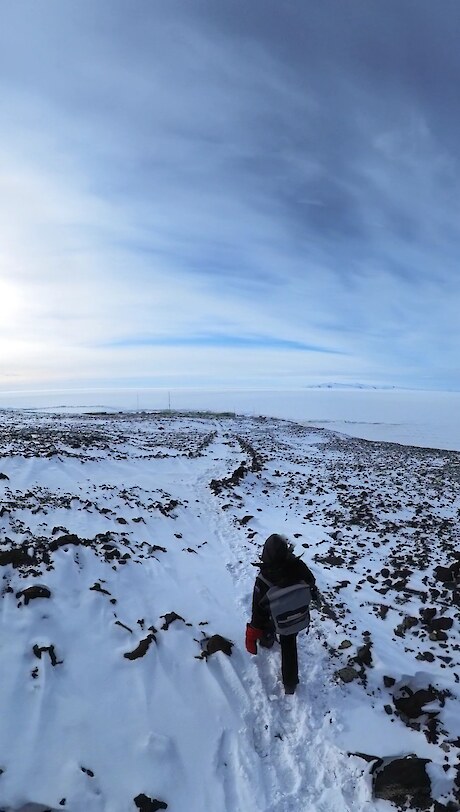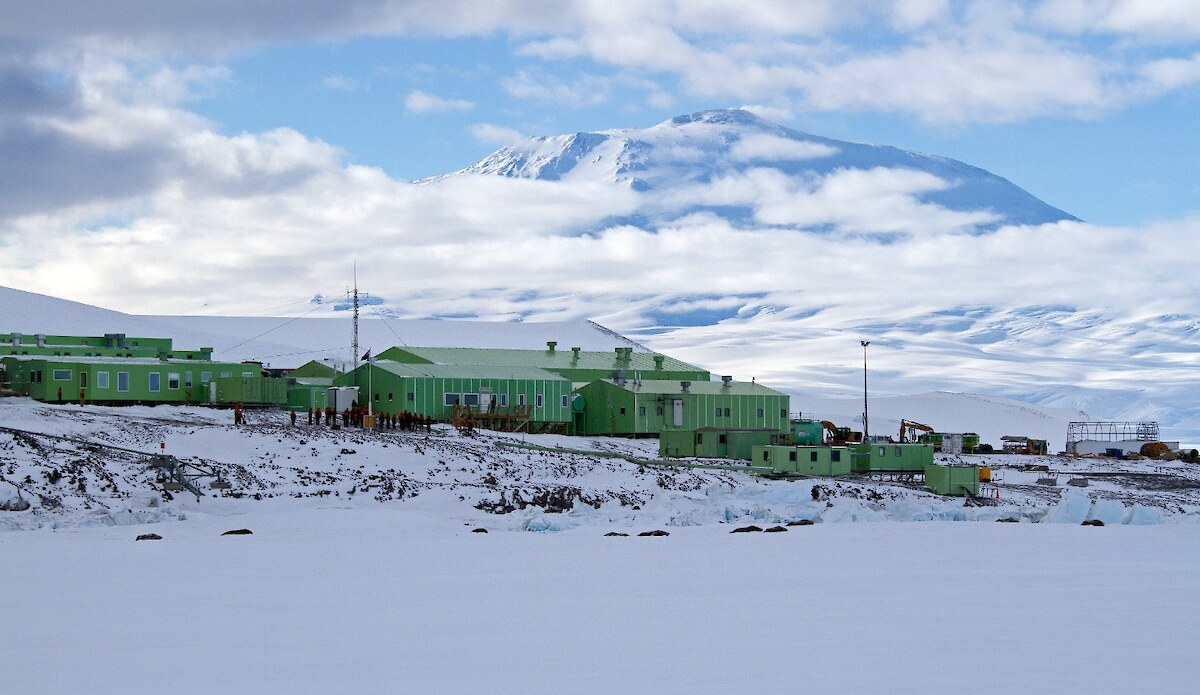 Photo credit A. PowellR. Eisert, Rewi Davis
Photo credit A. PowellR. Eisert, Rewi Davis
As part of the second research season of the Murihiku ki Te Tonga programme, Ngāi Tahu Team Lead, and Oraka Aparima representative Rewi Davis, visited Scott Base yesterday to pay respects to the Ngāi Tahu Pou Whenua.
The Pou Whenua was unveiled at Scott Base by then Ngai Tahu Kaiwhakahaere Mark Solomon, and then-PM John Key in January 2013. This visit forms part of a cultural and programme narrative, which links Te Waipounamu to the New Zealand Subantarctic Islands and into the Ross Sea Sector.
The Murihiku Expedition Team, consisting of Rewi Davis, Anthony Powell, and science lead Dr Regina Eisert, is traveling south on the Heritage Adventurer, a purpose-built 124-m long polar exploration vessel owned by Christchurch-based company Heritage Expeditions. Coming ashore in a zodiac at Hut Point, the site of Robert Falcon Scott’s first headquarters in Antarctica, the team walked through the US McMurdo Station and over the hill to Scott Base, a distance of about 3 km.
The Antarctic summer is already fading into autumn and the team walked into an extremely brisk wind that froze the breath on their balaclavas. But it was all worth it for the stunning views across the expanse of sea ice and the ethereal mountains beyond.
Taking a shortcut via Hillary’s Track down the hill to Scott Base, the Team took a break in the TAE Hut, the original Scott Base set up by Sir Edmund Hillary in 1957 as part of his Transantarctic Expedition. The TAE Hut has been restored meticulously, from the giant coal stove in the kitchen to the period equipment in the radio room. As a poignant reminder, the bookshelf displayed a 1977 brochure from Air New Zealand advertising flights to Antarctica – for $245.
After some chocolate (the meal of choice for Antarctic explorers), the Team visited the Pou Whenua, outlined in the morning sun and Rewi shared a simple Karakia to acknowledge the moment.
Kia hora Marino
Kia whakapapa pounamu te moana
Hei huarahi mā tatou I te rangi nei
Aroha atu aroha mai
Tātou I a tatou katoa
Hui e Taiki e!
May peace be widespread
May the sea be like greenstone
A pathway for all of us!
Let us show respect for each other
Bind us all together!
“Being able to come and pay our respects to the Pou Whenua was important for our team. It was an amazing opportunity and experience, and not one I will soon forget” confirmed Rewi Davis.
Toiling back up the hill, the team was picked up by a kind person in a very large red truck, who took them back to the ship’s landing in wonderful comfort. After a quick tour of Scott’s historic hut, the team rejoined the ship to continue their expedition.
************
Stuff Article about the Pou Whenua from 2013:
https://www.stuff.co.nz/the-press/news/8200978/Ngai-Tahu-carving-unveiled-in-Antarctica
the article does not name the carver, I thought I saw in a Te Karaka article it was Faye Robinson, or maybe James York
Ngai Tahu carving unveiled in Antarctica
January 21, 2013, • 02:56am
New Zealand’s Maori links have been stamped firmly on Antarctica today with the unveiling of a pou whenua at Scott Base’s 56th birthday.
Ngai Tahu leader Sir Mark Solomon and Prime Minister John Key jointly uncovered the totara carving in a formal ceremony this morning with Scott Base staff and invited guests from the United States’ McMurdo Station.
As they removed the sleeping bag covering, the sun briefly shone and a patch of blue sky appeared above, a brief break in the constant snowfall that has blanketed the base since soon after the Prime Minister arrived on Friday.
Solomon joked with the crowd that the pou did not mean Ngai Tahu was about to lodge a claim on Antarctica.
”I thought I better reassure the Prime Minister that.”
He said it was a privilege that Ngai Tahu, as the southern-most iwi, was asked to carve the pou.
The pou, called Navigator of the Heavens, was made of totara from the West Coast, which he was confident would withstand the rigors of Antarctica’s harsh environment, despite it developing several cracks since its arrival on the frozen continent.
Key said the pou was a ”very meaningful addition” to the base.
”Scott Base has a place in the hearts and minds of New Zealanders even if they haven’t visited here. Maori culture is enshrined in who we are as New Zealanders and to have this representation here is a lovely touch.”
Two woven tukutuku panels were also unveiled, a project headed by Ngai Tahu master weaver Ranui Ngarimu, kaiawhina to Sir Mark.
One panel symbolised Maori ancestors interwoven with New Zealanders who had died in Antarctica, including the 257 passengers and crew killed in the 1979 Mt Erebus plane crash.
The other paid tribute to the scientific work ongoing on the southern-most continent. Photo credit R. Eisert
Photo credit R. Eisert
West Coast weavers from Arahuru, Ngai Tahu’s main pounamu site, wove the tukutuku but Scott Base staff also helped, Ngarimu said.
Antarctica New Zealand chief executive Lou Sanson said about a third of his staff at the base were military and many were Maori.
Several years ago, the issue was raised of enhancing the cultural identity of New Zealand’s Antarctic base, which led to the pou’s inception.
A new carved wooden sign for Scott Base was also unveiled today.
Scott Base’s asset management team leader, Johno Leitch, said staff had to use jackhammers to dig a metre-deep hole, filling it with concrete to ensure the pou could withstand the strong winds that can batter Scott Base.
This afternoon, Key will visit the Dry Valleys to view scientific research underway there and also a penguin colony, which he had visited before but said he wanted to show his wife, Bronagh, who has joined him on his trip to the frozen continent.
Key said improving weather had boosted his chances of flying to the South Pole tomorrow but he was awaiting a final decision.
- The Press

